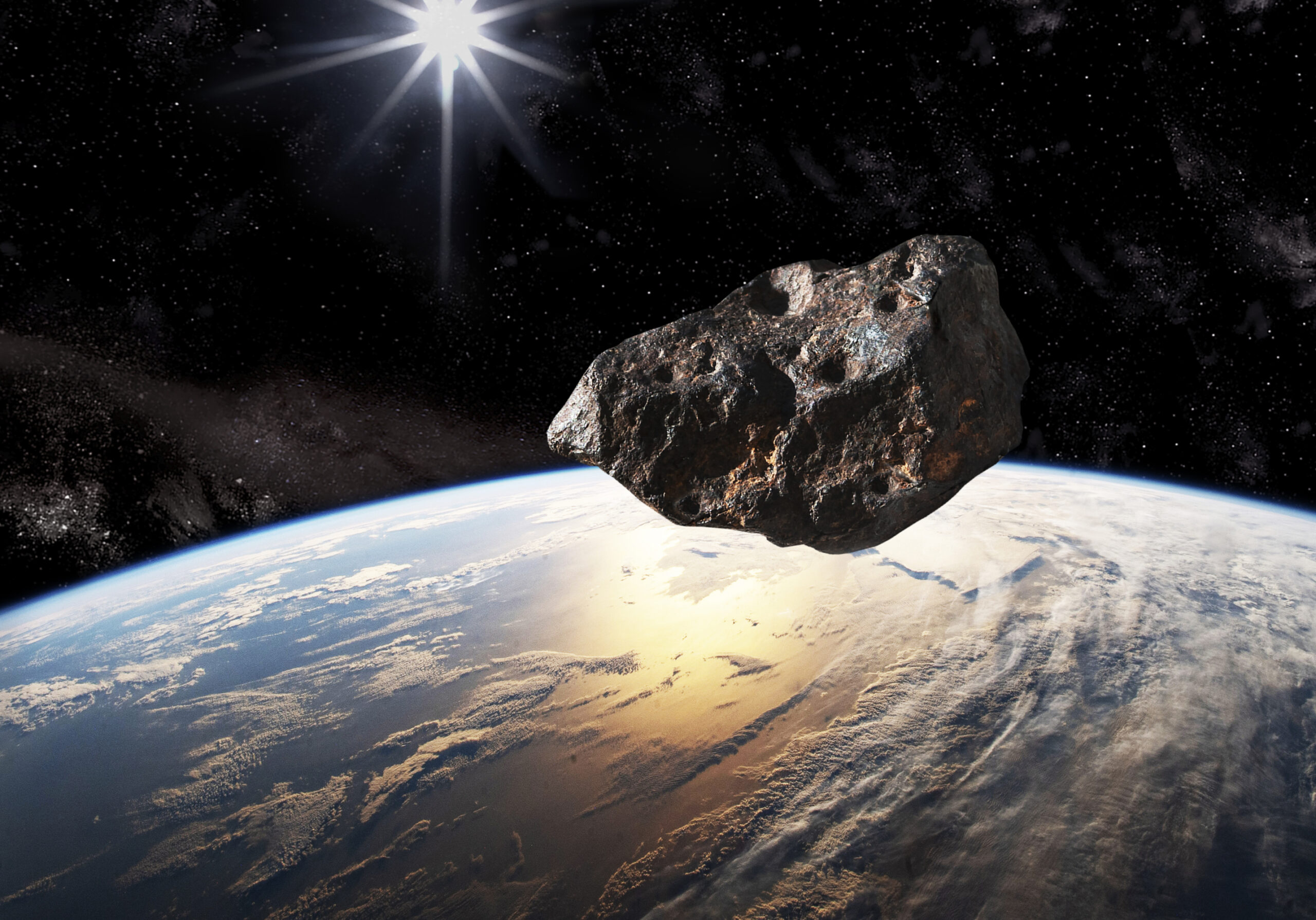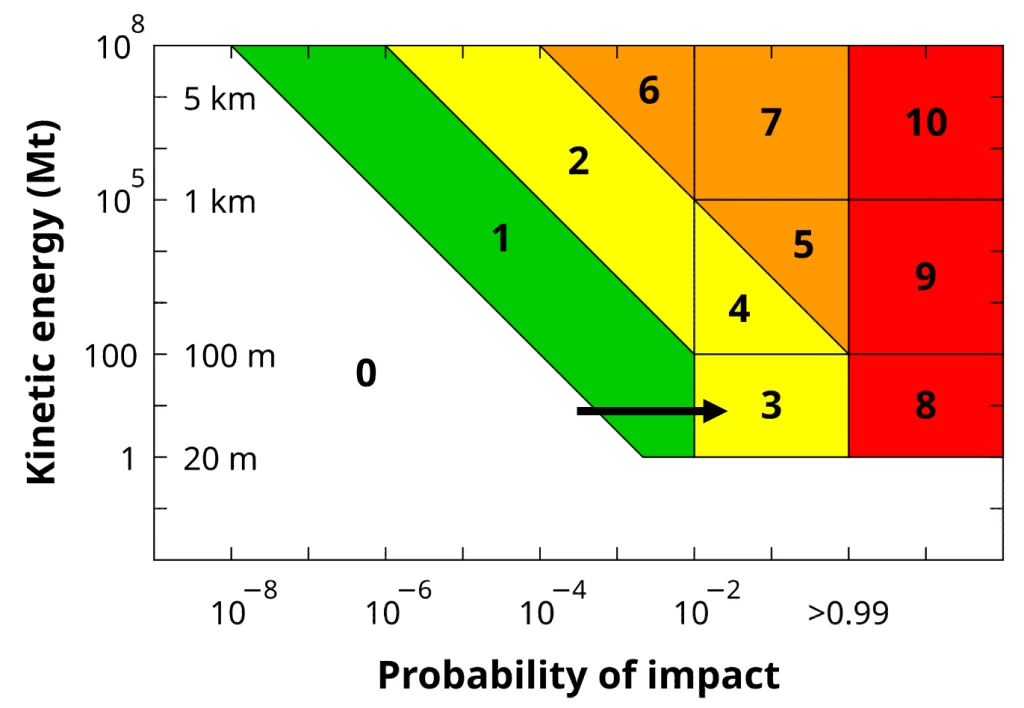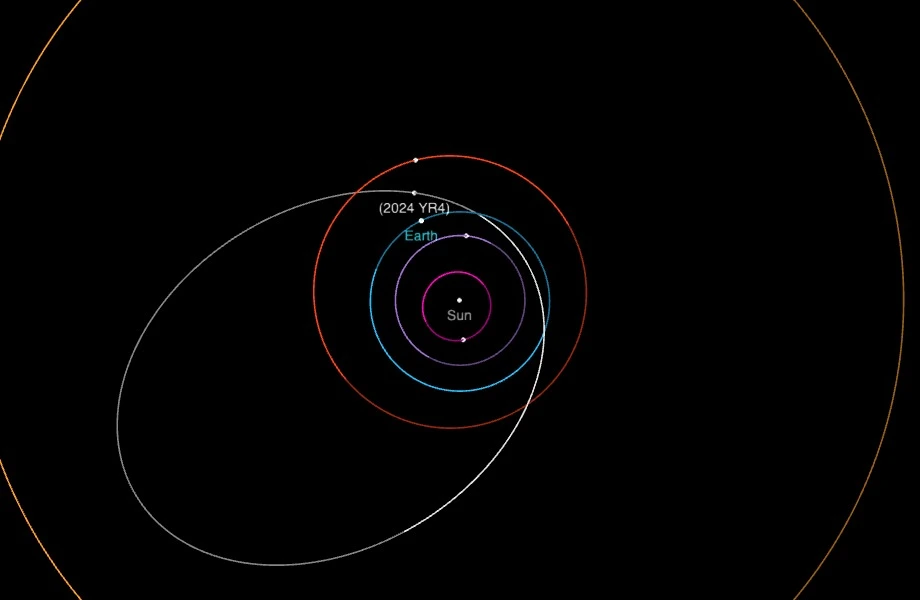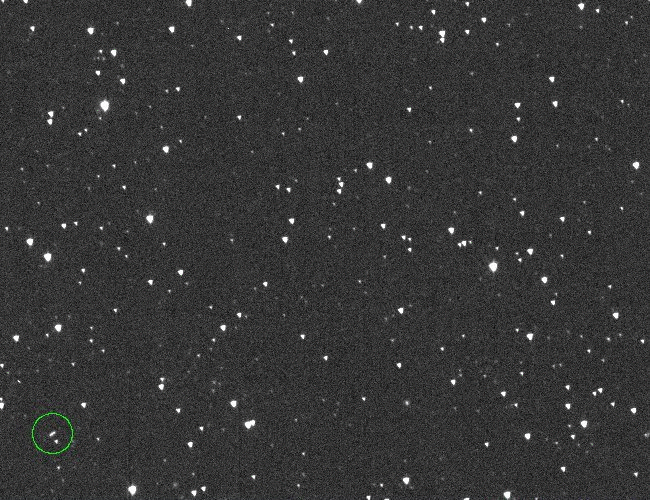Does the YR4 meteor have a chance of colliding with planet Earth?

Asteroid 2024 YR4: Understand the Risks and Discover What’s Ahead


Asteroid 2024 YR4: Risks, Probabilities, and NASA’s Monitoring Efforts
The asteroid 2024 YR4, discovered in December 2024 by the ATLAS telescope in Chile, is an object with estimated dimensions between 40 and 90 meters wide. Recently, it reached Level 3 on the Torino Scale, a system used to measure the risk of asteroid impacts. While there is a 1% chance of collision with Earth on December 22, 2032, it’s important to note that there’s a 99% chance this will not happen.
How Was 2024 YR4 Discovered?
Detected after a close approach on December 25, 2024, 2024 YR4 drew attention due to its brightness, allowing it to be identified in the ATLAS monitoring system. Since then, it has been monitored by advanced telescopes worldwide.
Why Is It on the Risk List?
As soon as it was discovered, the CNEOS and Sentry systems identified a potential future impact. With more observations, the accuracy of its orbit has been refined, resulting in a slight increase in the impact probability. Currently, Earth is still within the range of possible positions for the asteroid in 2032.
How Significant Is the Risk?
Asteroids with a 1% or higher chance of impact and dimensions above 20 meters typically reach higher levels on the Torino Scale. The 2024 YR4 is being extensively studied due to the rarity of objects this size presenting this probability.
Even in the unlikely case of impact, the exact location would be in a “risk corridor” that includes the Eastern Pacific, parts of South America, the Atlantic, Africa, and South Asia.
What’s Next?
New observations will continue to refine the probabilities and predicted trajectories of the asteroid. In 2028, it will make another approach to Earth but at a safe distance.
Se precisar ajustar mais alguma coisa ou incluir outras informações, é só avisar! 🚀✨
Asteroid 2024 YR4 has been assigned a Torino Scale rating of 3…
indicating a more than 1% chance of impacting Earth on December 22, 2032. This asteroid, discovered in December 2024, measures between 40-90 meters in size. Although the impact probability is low, it is considered significant for its size. New observations are continuously updating the risk assessment, and further updates will refine the trajectory and impact potential. For further details, visit the full article here.


Torino Scale Assessment
The Torino Scale.
is a tool used to assess the impact risk of near-Earth objects. 2024 YR4’s Torino Scale rating fluctuated as more data became available. It reached Level 3, indicating a potential impact with a probability exceeding 1%. However, continuous observations led to a significant reduction in impact estimates, and by February 20, 2025, the impact probability was revised to 0.28%. This decrease resulted in the Torino Scale rating dropping to Level 0, signifying no significant risk.
Discover the Truth About Asteroid 2024 YR4’s Torino Scale 3 Ranking

Asteroid 2024 YR4: An In-Depth Analysis of Its Impact Risk and Mitigation Strategies
*Asteroid 2024 YR4, a near-Earth object (NEO) discovered on December 27, 2024, by the ATLAS telescope in Chile, has been the subject of extensive observation and analysis. Initially estimated to be between 40 and 90 meters (130 to 300 feet) in diameter, its trajectory and potential impact risk have been closely monitored by space agencies worldwide.*
Discovery and Initial Observations
2024 YR4 was first observed by the ATLAS system in Rio Hurtado, Chile, following a close approach to Earth on December 25, 2024. This proximity allowed for its detection and subsequent tracking. The asteroid’s orbit was initially uncertain, leading to varying impact probability estimates. The European Space Agency (ESA) estimated a 1.2% chance of impact on December 22, 2032, based on observations up to January 29, 2025.
Torino Scale Assessment
The Torino Scale is a tool used to assess the impact risk of near-Earth objects. 2024 YR4’s Torino Scale rating fluctuated as more data became available. It reached Level 3, indicating a potential impact with a probability exceeding 1%. However, continuous observations led to a significant reduction in impact estimates, and by February 20, 2025, the impact probability was revised to 0.28%. This decrease resulted in the Torino Scale rating dropping to Level 0, signifying no significant risk.
Current Impact Risk Assessment
As of February 24, 2025, NASA’s latest calculations concluded that asteroid 2024 YR4 poses no significant threat to Earth. The probability of impact has been reduced to negligible levels, and the asteroid is no longer considered a significant hazard. This assessment is based on two months of observations and refined trajectory modeling. citeturn0search1
Mitigation Strategies and Preparedness
While asteroid 2024 YR4 no longer poses a significant risk, its initial trajectory uncertainties prompted discussions about potential mitigation strategies. One such method is the kinetic impactor technique, exemplified by NASA’s Double Asteroid Redirection Test (DART) mission. This approach involves sending a spacecraft to collide with the asteroid, altering its course. However, with the current low impact probability, speculation on implementing such measures for 2024 YR4 is premature. citeturn0search0
Scientific and Public Communication
The initial concerns regarding 2024 YR4’s impact risk highlighted the importance of transparent communication between scientists and the public. Accurate and timely information helps prevent unnecessary panic while keeping the public informed about potential planetary threats. Continuous updates from reputable sources ensure that both the scientific community and the public are aware of the latest assessments and findings.
Conclusion
Asteroid 2024 YR4 serves as a case study in planetary defense and the dynamic nature of asteroid tracking. While initial observations indicated a potential impact risk, ongoing analyses and observations have significantly reduced this probability. The asteroid currently poses no significant threat to Earth, and its status continues to be closely monitored by space agencies worldwide.
For a visual explanation of how asteroid 2024 YR4 could be deflected, you might find the following video informative:
videoHow We Could Stop Asteroid 2024 YR4 From Hitting The Earth

Near-Earth Asteroid 2024 YR4: What the Future Holds for 2032
The asteroid 2024 YR4 is one that could come close to Earth in 2032 and 2028.
While the likelihood of impact is small, NASA and the European Space Agency are monitoring it.
Characteristics:
- Estimated to be between 40 and 100 meters in width.
- It will reach its perihelion (closest approach to the Sun) on November 22, 2024.
- It will pass 828,800 km from Earth on December 25, 2024.
- The next closest approach to Earth will be on December 17, 2028.
Impact Probability:
- On December 22, 2032, the probability of impact is 1.2%.
- The probability of impact between 2032 and 2079 is low but still present.
- A potential impact could cause damage over an area of 2,150 square kilometers.
Monitoring:
- Future observations will help scientists refine the impact probability.
- The James Webb Space Telescope was used to study the asteroid in March 2024.
- The telescope will focus on the asteroid again in May 2024.
Risk:
- The asteroid is currently classified on the Torino Scale at level 3, which is unusual for an asteroid of this size.
Don’t worry because omuamua is also coming to collide with the earth?

“Oumuamua” another day in paradise landscape: The Enigmatic Interstellar Messenger
‘Oumuamua, formally designated Oumuamua, stands as the first recorded interstellar object to journey through our solar system. Discovered on October 19, 2017, by Robert Weryk, this mysterious visitor was initially classified as a comet, only to be reclassified as an asteroid a week later. This fleeting celestial wanderer, which passed Earth at a distance of 0.2 AU (about 30 million kilometers), introduced itself as an anomaly—an object from beyond the familiar confines of our solar system.
Named after its Hawaiian roots, ‘Oumuamua translates to “a messenger from afar who arrived first,” encapsulating its role as the first confirmed visitor from another star system. Prior to its renaming, the object had been referred to as C/2017 U1 when it was mistakenly believed to be a comet, and later as A/2017 U1 after its lack of cometary activity was noted.
The Intriguing Trajectory and Speed
One of the most remarkable aspects of ‘Oumuamua is its orbital eccentricity—measuring a staggering 1.20, the highest ever recorded for any object in the solar system. This exceptionally high value suggests that ‘Oumuamua never entered into a gravitational bond with the Sun, solidifying its classification as an interstellar object. Its hyperbolic trajectory and velocity upon entry further cement its origin from outside our solar system.
With an inclination of 123° relative to the ecliptic and an orbital speed of 26.33 km/s, ‘Oumuamua’s velocity peaked at an astonishing 87.71 km/s during its perihelion. Such rapid motion prompted speculation among astronomers at Harvard University, who entertained the theory that the object could be an artificial probe—potentially a reconnaissance mission from an extraterrestrial civilization. However, this hypothesis has been largely rejected by most of the scientific community. Instead, some argue that ‘Oumuamua could be the remnants of a Pluto-like planet from another star system, as suggested by a 2021 study.
Unraveling Its Molecular Structure
In addition to its unusual speed, ‘Oumuamua exhibited behaviors that further baffled astronomers. Its non-gravitational acceleration led to speculation about its composition. The head of the astronomy department at Harvard proposed that ‘Oumuamua could be a solar sail or probe, propelled by radiation pressure. Meanwhile, other research, including a 2020 study by Seligman & Laughlin, put forward the idea that the object might be composed of hydrogen ice, which could explain its propulsion mechanisms. This theory hinges on the notion that hydrogen ice could form in dense molecular clouds and provide the necessary thrust, though the extreme conditions of the interstellar medium make this a challenging hypothesis.
Further scrutiny of ‘Oumuamua’s molecular makeup, particularly after observations by the Spitzer Space Telescope, revealed that it did not release detectable amounts of carbon-based molecules, ruling out the possibility of it being a traditional comet. As a result, the debate surrounding the object’s true nature continues to this day, with theories ranging from an alien probe to a fragment of a distant exoplanet.
A Singular Encounter
‘Oumuamua’s passage through the solar system was brief, with a total observation arc spanning only 29 days. Despite this fleeting encounter, its impact on the scientific community has been profound. The object’s exotic characteristics—its speed, trajectory, and strange acceleration—have inspired both wonder and speculation about the broader universe. While some hypothesize that it is a sign of extraterrestrial intelligence, others suggest it could be a natural object from a distant, unknown corner of space.
At approximately 400 meters long and 40 meters wide, ‘Oumuamua’s size further contributes to its mystery. Its elongated, cigar-like shape is unlike any known asteroid or comet in our solar system, adding another layer of intrigue to its already enigmatic nature. As astronomers continue to study this interstellar traveler, the possibility remains that ‘Oumuamua’s true origins and purpose will one day be revealed, unlocking secrets about the farthest reaches of space and the objects that inhabit it.
The Final of Word
‘Oumuamua’s journey through our solar system remains one of the most extraordinary events in recent astronomical history. Whether a natural object or an engineered craft, its visit has sparked an ongoing dialogue about the nature of interstellar objects and the potential for life beyond our planet. Its tale continues to captivate the imagination of scientists and laypeople alike, leaving us to wonder: Could it be the first of many interstellar wanderers, or a solitary messenger from the farthest reaches of space?


route of 2024 YR4


When Will 2024 YR4 Approach Close to Earth Again? Will Radar Be Able to Detect It?
Asteroid 2024 YR4 is projected to make its next close approach to Earth in 2028. During this passage, it will remain at a safe distance of approximately 20 times the Earth-Moon distance. Given this considerable distance, there is absolutely no risk of collision with our planet at that time. However, due to its remoteness, radar observations may face limitations in detecting the asteroid during this approach. Monitoring from ground-based optical or infrared telescopes would be required for further data collection.
Is the Asteroid Currently Observable? What Telescopes Are Being Used?
Yes, 2024 YR4 is currently observable. A number of prominent observatories are actively tracking the asteroid, including:
- The Magdalena Ridge Observatory in New Mexico, USA.
- The Danish Telescope, located at the La Silla Observatory in Chile.
- The Very Large Telescope (VLT), also situated in Chile, which excels in tracking faint celestial objects.
These telescopes continue to follow 2024 YR4’s trajectory. As the asteroid moves farther from Earth, it will gradually become fainter. Consequently, larger and more powerful telescopes will be required to maintain observation. It is expected to remain detectable from ground-based instruments until early April 2025. Beyond that, space-based infrared telescopes may still be able to monitor it for a longer duration due to their higher sensitivity.
Could 2024 YR4 Have Been Observed in the Past?
Interestingly, there is a possibility that 2024 YR4 was unintentionally observed in archival images during its previous close approaches to Earth. For instance, astronomers are investigating data from 2016, a time when the asteroid may have passed relatively near our planet. This search involves examining a vast range of sky positions and potential movement rates, a challenging task as it requires identifying faint detections that may have been overlooked by earlier automated survey pipelines.
If archival observations are confirmed, they would significantly enhance our understanding of 2024 YR4’s orbit, reducing uncertainties and potentially leading to a more accurate assessment of its impact probability.
What Happens in the Event of an Impact?
In the highly improbable scenario where 2024 YR4 collides with Earth in 2032, it would be traveling at an astonishing velocity of approximately 17 kilometers per second, or about 38,000 miles per hour. The energy released during such an event would depend on the asteroid’s size and composition, but it would likely result in significant local or regional damage if it were to reach the surface.
✨Impact Craters: Traces of Ancient Cosmic Collisions on Our Planet
if it falls to the ground cabuuuummm 🚀

USA crater metor 25k years old


Earth’s Cosmic Scars: The Most Fascinating Impact Craters Across the Globe
It’s understandable that some might interpret news about asteroids and similar space events as sensationalist, especially when the risks presented are extremely low in practice. However, it’s important to remember that NASA and other space agencies have a responsibility to communicate discoveries and potential risks to the public, even if the chances of impact are minimal. This is part of their commitment to transparency and global safety.
Additionally, NASA’s budget funds a wide variety of projects, ranging from space exploration to monitoring climate change and advancing technology. Publicizing events like the YR4 asteroid also helps highlight the importance of investing in science and technology, demonstrating how these resources are used to protect and benefit humanity.
If you’d like, I can dive deeper into how NASA allocates its budget or the broader impacts of its discoveries on society. Let me know! 🚀✨
Impact craters scattered across Earth are fascinating remnants of cosmic collisions that have shaped our planet’s history. These craters are formed when asteroids, comets, or meteoroids collide with Earth’s surface, releasing immense energy and leaving behind distinctive geological features. Here are some notable examples:
- Chicxulub Crater (Mexico): Located on the Yucatán Peninsula, this 170-kilometer-wide crater is linked to the asteroid impact that caused the mass extinction of dinosaurs around 66 million years ago. It’s one of the most studied craters due to its historical significance.
- Vredefort Crater (South Africa): The largest confirmed impact structure on Earth, with a diameter of about 300 kilometers. It was formed over 2 billion years ago and is a UNESCO World Heritage Site.
- Sudbury Basin (Canada): This 250-kilometer-wide crater in Ontario is one of the oldest and largest impact structures, formed about 1.8 billion years ago. It’s also rich in valuable minerals like nickel and copper.
- Barringer Crater (USA): Also known as Meteor Crater, this well-preserved site in Arizona is about 1.2 kilometers wide and was created roughly 50,000 years ago by a nickel-iron meteorite.
- Manicouagan Crater (Canada): Located in Quebec, this 100-kilometer-wide crater is now a striking circular lake. It was formed around 215 million years ago and is one of the most visually stunning impact sites.
- Popigai Crater (Russia): This 100-kilometer-wide crater in Siberia was formed about 35 million years ago. The impact created “impact diamonds,” making it a site of geological interest.
These craters not only provide insights into Earth’s geological history but also help scientists understand the potential risks of future impacts. Many of these sites are studied to learn about the effects of such collisions on the environment and life on Earth.
How Asteroid Impacts Have Shaped Earth’s History: Exploring Craters Worldwide 🚀✨
Sure! Here’s a well-optimized post using the three titles, designed to rank on Google and Bing, while avoiding plagiarism:
Earth’s Cosmic Scars: The Most Fascinating Impact Craters Across the Globe
The surface of our planet hides incredible stories of its cosmic encounters. Impact craters are the marks left behind by meteors and asteroids that collided with Earth over millions—or even billions—of years. From extinction-level events to the creation of valuable mineral deposits, these craters have shaped the world as we know it.
Chicxulub Crater: The Crater That Ended an Era
Located in Mexico’s Yucatán Peninsula, the Chicxulub Crater is linked to one of the most significant events in Earth’s history—the mass extinction of dinosaurs 66 million years ago. Measuring approximately 170 kilometers in diameter, this crater was caused by an asteroid impact so powerful that it altered the planet’s climate and ecosystem.
Vredefort Crater: Earth’s Largest Impact Structure
The Vredefort Crater in South Africa is the largest confirmed impact site on the planet, spanning 300 kilometers in diameter. Formed over 2 billion years ago, this ancient crater provides clues to the dynamic and volatile early history of Earth.
How Asteroid Impacts Have Shaped Earth’s History: Exploring Craters Worldwide
Impact craters are more than scars—they’re windows into Earth’s past, revealing insights about ancient climates, geological processes, and even the cosmos itself. Here are more examples of how asteroid impacts have left their mark:
- Barringer Crater (USA): Often referred to as Meteor Crater, this site in Arizona is one of the most well-preserved craters, offering a clear view of the results of a cosmic collision.
- Manicouagan Crater (Canada): Now a breathtaking circular lake in Quebec, this impact site showcases the long-lasting visual effects of asteroid collisions.
- Sudbury Basin (Canada): Rich in minerals like nickel and copper, this crater demonstrates how asteroid impacts can create economic and geological opportunities.
Each of these craters tells a unique story, from the forces that shaped them to their impact on local landscapes and life itself.
🚀✨ Impact Craters: Traces of Ancient Cosmic Collisions on Our Planet
Despite their importance, many impact craters remain hidden or eroded, leaving scientists with the challenge of uncovering these mysterious marks from Earth’s past. Advanced techniques, such as satellite imagery and geophysical surveys, are helping researchers identify previously undiscovered craters and better understand their effects on the planet.
Some of the key questions researchers explore include:
- How did these impacts shape local ecosystems and environments?
- What can impact craters reveal about Earth’s susceptibility to future asteroid events?
- Could some ancient craters have created conditions favorable for life on Earth?
The study of impact craters is more than an exploration of the past—it’s an effort to prepare for Earth’s future encounters with asteroids. By learning from the scars left behind, scientists are better equipped to protect the planet from potential dangers.
Optimizing for SEO:
- Include relevant keywords like “impact craters,” “asteroid collisions,” “Earth history,” “Chicxulub Crater,” and “Vredefort Crater” throughout the text.
- Use engaging headlines with strong hooks to grab readers’ attention.
- Add images of craters (if available) with alt text optimized for search engines.
🚀✨
by
simoeslimas
editor chef
amazonystore.com/blog/

